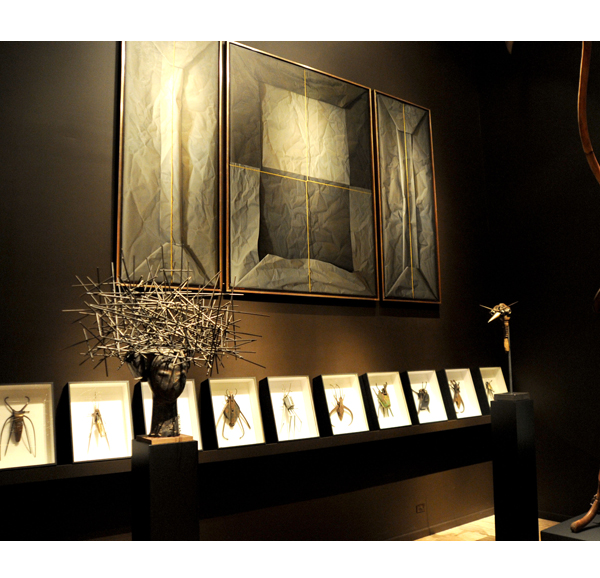Thierry’s Toys

PHOTO COURTESY OF NEIL RASMUS/BILLY FARRELL AGENCY
Enthusiasm permeated the former headquarters of the New York Mercantile Exchange, in Tribeca, as the crowd of artists, collectors and friends scaled a cast-iron staircase to enter Le Cabinet de Curiosités, an art environment conceived and curated by French-born artist Thierry W. Despont. The exhibition, an unusual off-site project by Marlborough Fine Art and the Steinitz Gallery, the famed dealer of period furniture and antiques from its home base on rue du Faubourg Saint Honoré, is a feast for the eyes, a thing of pleasure and regret.
The father-and-son team from Steinitz—Bernard and Benjamin—shipped a great deal of dazzling 18th-century boiserie and objets d’art, to transform the drab loft into a labyrinthine Second Empire apartment. Organized into five airy rooms, the space quickly filled up with an eclectic selection of guests, which included Princess Firyal of Jordan, Cindy Sherman, Ondine de Rothschild, Prosper Assouline, Olivier Berggruen, Frank de Biasi, and Maguy Le Coze. Here comes that sun-kissed gentleman in hot-pink corduroys and jewel-encrusted black velvet slippers, an ageless beauty ensconced in sable on his arm. What’s Labor Day? Recession?
Napoleon Bonaparte’s 1810s map table, which later belonged to his sister Elisa, was a popular piece. “We must go!” shrieked a black-clad Frenchwoman, as someone swiftly tilted the top to reveal the table’s cartographic functionality. (Note to prospective buyers: a sticker price in the upper seven figures has been bandied about.) A bevy of men tiptoed around the thing, channeling their inner machismo and charting their own strategies—if only for the evening. Or perhaps they were contemplating the grit and glory of Austerlitz, the alpine passage at Somosiera, the vanquished Grande Armée at Waterloo.
Thierry Despont, the unambiguous center of gravity at Le Cabinet, is a born charmer who seems to navigate social settings with a manner worthy of Stendahl: his manner elegant yet convivial, his mind and body in sustained unison. “I’m obsessed with being the cartographer of the dream world. It should take people literally into my dream,” he said of the exhibition. “What I like is the surprise of the unexpected,” he added, bouncing off into the adjacent room to enclasp his daughter. (“I don’t tell people my last name anymore,” she muttered.)
Indeed, Le Cabinet de Curiosités invites the viewer into a maze of memory. Antiques from Steinitz—a Renaissance bull’s head, a Japanese lacquered trunk from the Edo period—are strategically placed to avoid disrupting the experience, a testimony to Mr. Despont’s keen eye for design and architecture. A number of pieces from three contemporary artists on the Marlborough roster—Spanish sculptor Manolo Valdés; Chilean-born painter Claudio Bravo; and Mr. Despont himself—complement the marquetry of the interiors. Mr. Valdés’s bookcases made of blank, raw and exotic woods are playful and quite lovely—while wryly commenting on the fetishization of the book binding as a tool of interior design, they also evoke the bygone Imperial Library in Vienna (so aptly limned in Robert Musil’s The Man Without Qualities), where books and fine art were seen as the same.
Mr. Bravo, who passed away in June—and whose “artistic talent and memory,” in the words of Mr. Despont, “infuse the show”—has created paintings in his signature hyperralist style: crumpled paper, rectangular slivers of aluminum foil, the verso of a stretched canvas. These superb pieces are rendered with a poetic verisimilitude worthy of an Old Master and suffused with ravishing Mediterranean light (Mr. Bravo lived and worked in Tangiers since 1972). Mr. Despont’s assemblage sculptures resembling giant insects and fantastical creatures, as well as a glass-paneled astronomer’s cabinet, add a dust of boyish wonder to Le Cabinet.
In any case, Zeitgeist might be just the term to register upon viewing this eccentric and dreamy display. A mixed-media tribal mask seemed to invite immediate association with Beninese artist Romuald Hazoume’s brush-speakers-and-plastic mask from the Reconfiguring an African Icon summer show at the Met. The taxidermy-inspired sculpture reminded this reporter of an unusual piece at the Pavilion of Art and Design, whose inaugural New York iteration has recently closed: an early 20th-century model of a giant anteater cast in bronze by the lost wax process at the Hébrard Foundry in Paris, offered by the Sladmore Gallery.
The New York Times columnist Eve Kahn observed that Despont “drew inspiration from Deyrolle, a Parisian taxidermy store,” which this reporter chanced upon as a teenager strolling down the Boulevard Saint-Germain, the rapt American in Paris. Dating back to 1831, a few blocks from Musée d’Orsay, Deyrolle is a phantasmagoric realm of stuffed animals, skeletons and related sculpture. Both of the moment and of another time, the menagerie cameos as a wedding venue in Midnight in Paris, Woody Allen’s latest folly, which takes Owen Wilson back to the 1920s. Along with myriad other impressions, Le Cabinet might likewise summon visions of Jazz Age figures like Ernest Hemingway, Gertrude Stein and T.S. Eliot. In fact, Mr. Despont quotes the latter in an addendum to the stock press release: “Do not ask what is it? / Let us go and pay our visit. / In the room women come and go / Talking of Michelangelo.”






